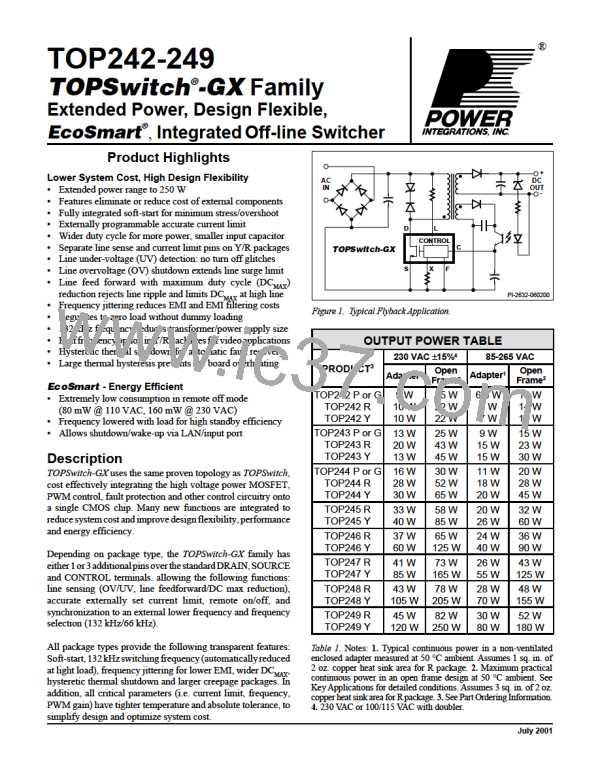TOP242-249
AHighEfficiency,Enclosed,70W,UniversalAdapterSupply
The circuit shown in figure 42 takes advantage of several of the
TOPSwitch-GX features to reduce cost, power supply size and
increase efficiency. This design delivers 70 W at 19 V, from an
85 to 265 VAC input, at an ambient of 40 °C, in a small sealed
adapter case (4” x 2.15” x 1”). Full load efficiency is 85% at 85
VAC rising to 90% at 230 VAC input.
Capacitor C11 has been added in parallel with VR1 to reduce
Zener clamp dissipation. With a switching frequency of
132 kHz a PQ26/20 core can be used to provide 70 W. To
maximize efficiency, by reducing winding losses, two output
windings are used each with their own dual 100 V Schottky
rectifier (D2 and D3). The frequency reduction feature of the
TOPSwitch-GX eliminates any dummy loading to maintain
regulation at no-load and reduces the no-load consumption of
thepowersupplytoonly520mWat230VACinput. Frequency
jittering provides conducted EMI meeting the CISPR 22
(FCC B) / EN55022B specification, using simple filter
components (C7, L2, L3 and C6) even with the output earth
grounded.
Due to the thermal environment of a sealed adapter a TOP249Y
is used to minimize device dissipation. Resistors R9 and R10
externally program the current limit level to just above the
operating peak DRAIN current at full load and low line. This
allowstheuseofasmallertransformercoresizewithoutsaturation
duringstartuporoutput loadtransients. ResistorsR9andR10also
reduce the current limit with increasing line voltage, limiting the
maximumoverloadpowerathighinputlinevoltage,removingthe
need for any protection circuitry on the secondary. Resistor R11
implements an under voltage and over voltage sense as well as
providing line feed forward for reduced output line frequency
ripple. With resistor R11 set at 2 MΩ the power supply does not
start operating until the DC rail voltage reaches 100 VDC. On
removal of the AC input the UV sense prevents the output
glitching as C1 discharges, turning off the TOPSwitch-GX when
theoutputregulationislostorwhentheinputvoltagefallstobelow
40 V, whichever occurs first. This same value of R11 sets the OV
threshold to 450 V. If exceeded, for example during a line surge,
TOPSwitch-GX stops switching for the duration of the surge
extending the high voltage withstand to 700 V without device
damage.
To regulate the output an optocoupler (U2) is used with a
secondary reference sensing the output voltage via a resistor
divider (U3, R4, R5, R6). Diode D4 and C15 filter and smooth
the output of the bias winding. Capacitor C15 (1uF) prevents
the bias voltage from falling during zero to full load transients.
Resistor R8 provides filtering of leakage inductance spikes
keeping the bias voltage constant even at high output loads.
Resistor R7, C9 and C10 together with C5 and R3 provide loop
compensation.
Due to the large primary currents, all the small signal control
components are connected to a separate source node that is
Kelvin connected to the source pin of the TOPSwitch-GX. For
improved common mode surge immunity the bias winding
common returns directly to the DC bulk capacitor (C1).
PERFORMANCE SUMMARY
D2
C7 2.2 nF
Y1 Safety
C13
0.33 µF 0.022 µF 0.01 µF
400 V 400 V 400 V
C12
C11
Output Power:
Regulation:
70 W
MBR20100
4%
Efficiency:
Ripple:
No Load Consumption:
≥ 84%
≤ 120 mV pk-pk
< 0.52 W @ 230 VAC
D3
MBR20100
VR1
P6KE-
200
C3
C14
19 V
@ 3.6 A
820 µF
0.1 µF
L1
200 µH
BR1
25 V
50 V
D1
RS805
UF4006
8A 600 V
C2
C4
RTN
820 µF
820 µF
R1
270 Ω
D4
1N4148
25 V
25 V
L2
820 µH
2A
R11
2 MΩ
1/2 W
R4
U2
31.6 kΩ
R8
4.7 Ω
PC817A
1%
C1
T1
TOPSwitch-GX
L
R2
150 µF
C15
1 µF
50 V
R5
562 Ω
1%
1 kΩ
400 V
C6
D
S
C9
0.1 µF
TOP249Y
L3
4.7 nF 50 V
X2
CONTROL
U1
75 µH
RT1
C
R9
2A
10 Ω
t°
13 MΩ
C10
1.7 A
R3
6.8 Ω
0.1 µF
R7
56 kΩ
X
F
F1
3.15 A
50 V
U3
TL431
C8
J1
R10
R6
4.75 kΩ
1%
0.1 µF
20.5 kΩ
C5
L
50 V
47 µF
16 V
All resistors 1/8 W 5% unless otherwise stated.
N
PI-2691-033001
Figure 42. 70 W Power Supply using Current Limit Reduction with Line and Line Sensing for UV and OV.
E
7/01
August 8, 2000
22

 POWERINT [ Power Integrations ]
POWERINT [ Power Integrations ]